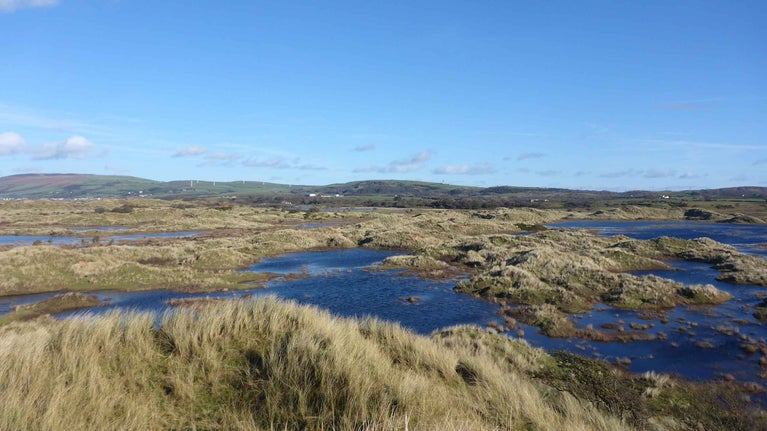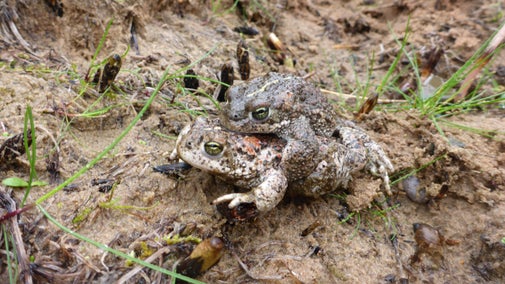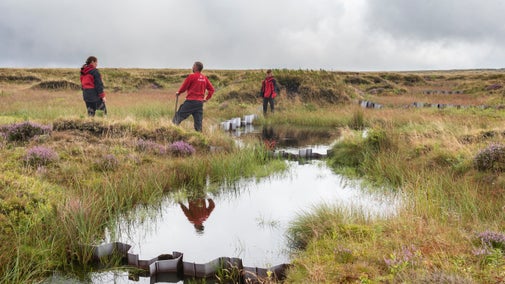
Donate
Everyone needs nature, now more than ever. Donate today and you could help people and nature to thrive at the places we care for.

While this rugged landscape may appear to be the handiwork of Mother Nature alone, there’s a lot of human help that goes into looking after this special place. Learn how our work at Sandscale Haws National Nature Reserve is a year-round effort, helping wildlife to thrive, sand dunes to breathe and improving visitor experience.
In 2024, we celebrated the 40th anniversary of Sandscale Haws coming under the National Trust’s care. It was a time to reflect on this unique and important nature reserve, and what it means to the people who visit and care for it.
The sandy estuary of the River Duddon, with its wild, grass-covered dunes and panoramic views of the Lakeland fells, is a much-loved local gem for residents in Barrow and Askham. Dedicated rangers and volunteers work year-round to keep the rugged landscape a happy home for wildflowers and wildlife.
We ask for your permission before anything is loaded, as this content may introduce additional cookies. You may want to read the Google YouTube terms of service and privacy policy before accepting.
We're so proud to present a special film marking 40 years of Sandscale Haws National Nature Reserve. Directed and written by Dom Bush (Land and Sky Media) and Nancy Burditt (Programming and Partnerships Officer) the film explores what Sandscale Haws means to the local community, visitors and wildlife alike.
Areas of bare sand provide the right kind of habitat for so much wildlife at Sandscale Haws and it’s a constant job for the ranger team to stop the whole of the sand dune system from turning into grassland.
Sandscale’s dunes are constantly changing and the oldest dunes here are around 400 years old.
Every year, especially in winter, they face constant battering by winds and sea, building them up and blowing them along the beach to create new dunes.
We call these new dunes ‘embryo’ dunes. They’re the little hummocks of sand which are made when the blown sand forms around grasses like sea lyme grass or sand couch. Their strong roots help to anchor the sand and slowly a dune develops.
Once the embryo dunes start to get more established and the grasses are completely engulfed by sand, the fast-growing marram grass takes over. It can survive the moving, shifting sand and can grow up to a metre in height every year. Most of the dunes at Sandscale Haws National Nature Reserve are now completely covered by grasses which eventually make the whole dune stable.
When it stops growing, other plants and grasses start to move in. These new dune grasslands are rich in wildlife, but the crucial pioneer habitats are gradually lost.
Since 1946 open bare sand habitats at Sandscale have dropped to under 2%. Mobile dunes are now only around the seaward edge of the nature reserve – everywhere else has been covered by grasses and scrub.
To help create a more open habitat the rangers have been trialling different methods:
Firstly, they’re creating bare patches of sand in the dunes using hand tools. Creating more open areas in the grassland to helps those rare pioneer plants to grow.
Secondly, sand is being encouraged to move inland. By creating weak points in the taller dunes which edge onto the beach, their aim is to encourage the bare dune sand to move towards the land and form openings (blowouts).
This helps to change the shape of the dunes and create new wet hollows (dune slack). This natural movement creates crucial pockets of bare sand which help rare pioneer plants to grow and solitary bees to burrow.
At wet times of year this creates a shallow pool which provides an ideal habitat for breeding natterjack toads and plants such as variegated horsetail.

Over the winter contractors have been on site to do some clearing in preparation for the new English Coast path, a project which will bring benefit for both people and nature.
The English Coast Path will bring a well-marked route to Sandscale Haws, connecting the reserve up with the rest of Cumbria’s coastline. It will also bring users of the coast path and carpark away from an important breeding pool and foraging ground for natterjack toads, minimising the risk of erosion and disruption to sensitive habitats.
This new route has opened up an old sand dune, previously dominated by bracken, creating a new habitat for rare species which depend on bare sand –a habitat Sandscale Haws needs more of as it gives natterjack toads somewhere to burrow for hibernation. This is part of a wider programme of bare sand creation across the site, carried out as part of Dynamic Dunescapes. In the next few months, it’ll start to regenerate and colonise with some beautiful and scarce plants.
Learn more about the English Coast Path, which will stretch for almost 3,000 miles and be one of the longest continuous walking routes in the world.
Cows are our conservation heroes. Look out for them grazing the dune grassland as you walk around the reserve. Without them, the sand dunes would be covered in a thick blanket of scrub.
By eating the coarse grasses and young scrub like hawthorn, cows are helping us create space for the less competitive and sensitive plants and flowers around Sandscale Haws.
Letting cows graze also mimics a more natural way of grassland management, providing different heights of grassland which can attract all kinds of insects and wildlife.
Where the rangers have carried out grazing experiments, they can see that the grass in areas which hasn't been grazed is thick and coarse but in those areas which have been grazed they are rich in wildflowers.
Conservation grazing uses traditional breeds of cows such as Highland cattle and Galloways because they’re happy to eat some tougher, thornier plants and can survive quite happily all year round. Our rangers work closely with National Trust tenant farmers to graze the right numbers of cattle in the right place and at the best time of year.
Each breed of cattle has a different sort of temperament, and our tenant farmers carefully plan which animals they are going to choose to graze sites with lots of public access.
Cows can be alarmed by dogs which are not under control so please keep your dog on a lead around cattle.
Nature creates the best habitats for wildlife but sometimes it needs a helping hand. Managing pools created for the natterjack toads is a big annual job for the rangers and volunteers.
The pools are fed by water from the nearby Hawthwaite Beck. A sluice controlling the water level allows the rangers to keep the pools wet in the summer months for the toads when other natural pools have dried up.
It's a cold, wet and muddy job in the winter for the rangers and volunteers as they clear the plants and debris out of the pools. If this wasn't done, the pools would become too shaded for the toads and their toadlets to survive.
Up to 20 pairs of toads have bred in these pools. One year there was a count of 80,000 toadlets in one pool making them perfect ‘nursery pools’.
Tall grasses and scrub like hawthorn, gorse and bramble can eventually take over the sand dunes as they get older. Climate change, amongst other things, has made the conditions perfect for scrub to spread and grow.
Even with cattle grazing the young scrub, hawthorn, gorse and bramble can continue to grow and take over. Our rangers and volunteers at Sandscale Haws work hard each year to clear the scrub and make way for the flowers by carrying out an annual cutting of the scrub.
Look out for the friendly team carrying out their winter task of cutting and dragging the scrub over lots of dunes as they burn the scrub brash on a bonfire.
The fires are raised up off the ground on a metal platform to prevent any damage to the ground beneath and logs are taken to heat the ranger offices in the winter.

As Sandscale Haws is a National Nature Reserve one of the main jobs for the ranger team is to carry out research which helps future conservation projects both at Sandscale and all around the country.
The research we do varies, from counting breeding birds to measuring water levels in tubes called dipwells, so look out for them on the reserve when you’re walking.
In spring the rangers spend time counting natterjack toad spawn strings. The toads lay strings of spawn rather than clumps of spawn like frogs. Most female toads only breed once a year so one string usually equals one female toad. Counting the spawn strings means the rangers can monitor toad populations.
Spring and early summer is always a good time to count breeding birds at Sandscale. Some years this is wading birds like oystercatchers; in other years, it’s birds that use scrub habitat like stonechats or ground nesting birds like skylarks.
Across Sandscale, the rangers have fixed tubes into the ground called dipwells. These measure the level of ground water every hour with the help of data loggers which are fixed to the tubes.
By looking at the information that the dipwells have collected, the rangers can work out how groundwater moves across the site. This helps them to plan where they can create new areas for wildlife.
Summer is the perfect time to count the plants growing in the grassland. This is done by counting the plants in a square patch called a quadrat to get an idea of which plants are thriving and which aren’t.
With your ongoing support, we're able to continue our vital conservation work. Thank you for helping to protect these special places.

Everyone needs nature, now more than ever. Donate today and you could help people and nature to thrive at the places we care for.

Spot a wealth of wildlife at Sandscale Haws National Nature Reserve, and take in the panoramic views of the Duddon estuary and Lake District fells beyond.

Sandscale Haws is a great place to explore with your dog. To help keep this place special for other people and wildlife, please follow the Canine Code.

The National Trust, RSPB, Friends of the Lake District, Cumbria Wildlife Trust, and the Amphibian and Reptile Conservation Trust have joined forces to object to a proposed redevelopment at Roanhead Farm , which lies directly adjacent to the internationally significant nature sites.

We believe that nature, beauty and history are for everyone. That’s why we’re supporting wildlife, protecting historic sites and more. Find out about our work.

Read about our strategy, which focuses on restoring nature, ending unequal access and inspiring more people.

Together, we're securing our future with action on climate and the environment. Learn more about how we're responding to the changing climate at places in our care.